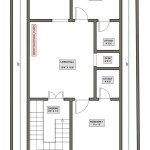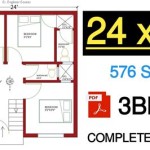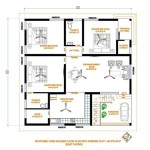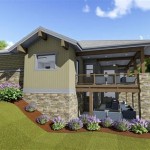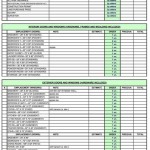One Bedroom One Bathroom House Plans: Maximizing Space and Efficiency
One bedroom, one bathroom house plans cater to a specific segment of the population seeking efficient, affordable, and manageable living spaces. These plans are commonly favored by single individuals, couples, retirees, or those looking for vacation homes or investment properties. The design philosophy often prioritizes functionality, open-concept living, and minimal maintenance, making them an attractive alternative to larger, more complex house plans.
The popularity of these plans is growing due to factors such as increasing urbanization, the rising cost of housing, and a desire for simpler lifestyles. As land becomes scarcer and more expensive, smaller homes offer a practical solution without sacrificing comfort or style. This article will explore various aspects of one-bedroom, one-bathroom house plans, examining key considerations, design options, and potential benefits.
Understanding the Target Demographic and Their Needs
Before diving into the specifics of house plans, it's crucial to understand the needs and preferences of the individuals who typically opt for one-bedroom, one-bathroom homes. This understanding informs the design process, ensuring that the final product aligns with the intended resident's lifestyle.
Single Individuals: This group often prioritizes affordability and low maintenance. The focus is on creating a comfortable and functional space for one person, with considerations for hobbies, work-from-home capabilities, and social gatherings. The design may incorporate dedicated office spaces, reading nooks, or entertainment areas.
Couples: While space is a consideration, couples often look for designs that promote togetherness and harmonious living. Open-concept layouts are popular, allowing for easy interaction and shared activities. Features like a well-equipped kitchen, comfortable living area, and a relaxing bedroom suite become paramount.
Retirees: Downsizing is a common motivation for retirees seeking one-bedroom homes. Ease of maintenance, accessibility features, and a focus on comfort are key considerations. Single-story designs, wider doorways, and grab bars in the bathroom are often incorporated to enhance safety and convenience.
Investors and Vacation Home Seekers: For these groups, the emphasis is on maximizing rental potential or creating a desirable vacation retreat. Low maintenance materials, durable finishes, and features that appeal to a broad range of renters or vacationers are important. The location and surrounding amenities also play a significant role in the overall appeal.
Key Design Considerations for One Bedroom, One Bathroom House Plans
Designing a functional and aesthetically pleasing one-bedroom, one-bathroom home requires careful consideration of several key factors. Space optimization, efficient layouts, and smart storage solutions are crucial for creating a comfortable and livable environment.
Open-Concept Living: This is a common and effective strategy for maximizing space in smaller homes. Combining the living room, dining area, and kitchen into a single open space creates a sense of spaciousness and facilitates natural light flow. Strategic use of furniture and area rugs can help define different zones within the open area.
Efficient Layouts: The layout of the house should be carefully planned to minimize wasted space and maximize functionality. Hallways should be kept to a minimum, and rooms should be designed with multiple uses in mind. For example, a breakfast bar can double as a workstation, or a guest bedroom can also serve as a home office.
Storage Solutions: Adequate storage is essential in smaller homes to prevent clutter and maintain a clean and organized living space. Built-in shelving, closet organizers, and under-bed storage are effective ways to maximize storage capacity. Vertical storage solutions, such as tall cabinets and shelves, can also help utilize space efficiently.
Natural Light and Ventilation: Ample natural light and ventilation can significantly enhance the feeling of spaciousness and comfort in a small home. Large windows, skylights, and strategically placed mirrors can help maximize natural light. Cross-ventilation, achieved by placing windows on opposite walls, can improve air circulation and reduce the need for artificial cooling.
Bathroom Design: The bathroom should be designed for both functionality and aesthetics. Space-saving fixtures, such as wall-mounted toilets and corner sinks, can help maximize floor space. A well-designed shower or tub-shower combination can provide a relaxing and functional bathing experience. Proper ventilation is crucial to prevent moisture buildup and mold growth.
Bedroom Design: The bedroom should be a comfortable and relaxing retreat. Adequate closet space, bedside tables, and proper lighting are essential. The size and layout of the bedroom should accommodate a comfortable bed and allow for easy movement around the room. Consider incorporating features like a walk-in closet or an ensuite bathroom for added convenience and luxury.
Exploring Different Styles and Floor Plan Options
One-bedroom, one-bathroom house plans come in a variety of styles and floor plan configurations to suit different preferences and lifestyles. From modern minimalist designs to cozy cottages, there are numerous options to choose from.
Modern/Contemporary: These plans typically feature clean lines, minimalist aesthetics, and open-concept layouts. Large windows, simple color palettes, and the use of modern materials are common characteristics. The focus is on creating a sleek and uncluttered living space.
Cottage/Bungalow: These plans often evoke a sense of warmth and charm with features like gabled roofs, dormer windows, and covered porches. The interior spaces are typically cozy and inviting, with fireplaces, exposed beams, and comfortable furnishings. These styles often maximize natural light and offer a close connection to the surrounding landscape.
Ranch: Ranch-style homes are characterized by their single-story design and open floor plans. They are often designed with accessibility in mind, making them a popular choice for retirees or those with mobility issues. Ranch homes typically feature attached garages and spacious yards.
Apartment-Style: These plans mimic the layout of an apartment, often featuring a compact and efficient design with all essential amenities within a single floor. They are ideal for urban settings or areas with limited space.
Loft-Style: Loft-style homes are characterized by their open floor plans, high ceilings, and exposed structural elements. They often feature large windows and industrial-inspired finishes. These plans are popular among those who appreciate a modern and unconventional living space.
Floor Plan Variations: Within each style, there are numerous floor plan variations to choose from. Some plans may prioritize a larger living area, while others may focus on a more spacious bedroom or a well-equipped kitchen. Consider the individual needs and preferences when selecting a floor plan.
Maximizing Functionality and Space-Saving Techniques
Given the limited square footage of one-bedroom, one-bathroom homes, maximizing functionality and incorporating space-saving techniques are essential. These strategies can help create a comfortable and livable environment without feeling cramped or cluttered.
Multi-Functional Furniture: Furniture that serves multiple purposes is a valuable asset in small homes. Examples include sofa beds, storage ottomans, and expandable dining tables. These pieces can adapt to different needs and maximize the use of available space.
Vertical Storage: Utilizing vertical space is a key strategy for maximizing storage capacity. Tall bookshelves, floating shelves, and wall-mounted cabinets can provide ample storage without taking up valuable floor space.
Pocket Doors: Pocket doors, which slide into the wall when open, can save space compared to traditional swing doors. They are particularly useful in hallways, bathrooms, and closets where space is limited.
Built-in Storage: Incorporating built-in storage solutions, such as built-in shelving, window seats with storage, and custom-designed closet organizers, can maximize storage capacity and create a clean and organized living space.
Smart Technology: Integrating smart home technology can enhance functionality and convenience in a small home. Smart lighting, thermostats, and security systems can be controlled remotely, allowing for efficient energy management and added security.
Minimalist Design: Embracing a minimalist design philosophy can help create a sense of spaciousness and order in a small home. Reducing clutter, using neutral color palettes, and selecting furniture with simple lines can create a calm and inviting atmosphere.
Cost Considerations and Building Options
The cost of building a one-bedroom, one-bathroom home can vary significantly depending on factors such as location, materials, and construction methods. However, these plans are generally more affordable to build than larger homes due to their smaller footprint and simplified design.
Material Selection: The choice of materials can significantly impact the cost of construction. Selecting durable and cost-effective materials, such as engineered wood flooring, laminate countertops, and fiber cement siding, can help reduce overall expenses.
Construction Methods: Traditional stick-built construction is a common method, but alternative methods such as prefabricated homes and modular construction can offer cost savings and faster construction times. Prefabricated homes are built in a factory and then assembled on-site, while modular homes are constructed in sections and then joined together. Both methods can reduce labor costs and minimize construction waste.
DIY Elements: Depending on individual skills and experience, incorporating DIY elements into the construction process can help reduce costs. Tasks such as painting, landscaping, and installing flooring can be done by the homeowner to save on labor expenses. However, it's important to ensure that all work is done to code and meets safety standards.
Energy Efficiency: Investing in energy-efficient features, such as energy-efficient windows, insulation, and appliances, can help reduce long-term operating costs. Energy-efficient homes require less energy for heating, cooling, and lighting, resulting in lower utility bills.
Permitting and Regulations: Obtaining the necessary permits and complying with local building codes is essential for any construction project. The cost of permits can vary depending on the location and the scope of the project. It's important to research local regulations and obtain all required permits before starting construction.
Financing Options: Several financing options are available for building a home, including construction loans, mortgages, and personal loans. The best option will depend on individual financial circumstances and creditworthiness. It's important to shop around and compare interest rates and terms before choosing a financing option.
Future Trends in One Bedroom, One Bathroom House Plans
The demand for one-bedroom, one-bathroom homes is expected to continue to grow in the coming years, driven by factors such as increasing urbanization, rising housing costs, and a desire for simpler lifestyles. Several trends are emerging in the design and construction of these homes.
Tiny Homes: The tiny home movement is gaining momentum, with many individuals embracing minimalist living and opting for homes that are less than 400 square feet. These homes often feature innovative space-saving techniques and sustainable building materials.
Accessory Dwelling Units (ADUs): ADUs, also known as granny flats or in-law suites, are small, self-contained living units that are located on the same property as a main house. They can be used as rental units, guest houses, or living spaces for family members. ADUs are becoming increasingly popular as a way to increase housing density and affordability.
Sustainable Design: Sustainable design principles are becoming increasingly important in the construction of one-bedroom, one-bathroom homes. This includes using eco-friendly materials, incorporating energy-efficient features, and designing homes that minimize their environmental impact.
Smart Home Technology: Smart home technology is becoming more prevalent in small homes, allowing residents to control lighting, temperature, security, and other systems remotely. Smart home devices can enhance convenience, energy efficiency, and security.
Universal Design: Universal design principles are being incorporated into the design of one-bedroom, one-bathroom homes to make them accessible to people of all ages and abilities. This includes features such as wider doorways, grab bars in the bathroom, and lever-style door handles.

With 1 Bed 2 Bath One Bedroom House Plans Small Floor

Ranch Style House Plan 1 Beds Baths 896 Sq Ft 771 One Bedroom Plans Small Floor

1 Bedroom Floor Plans Yahoo Search Results Small House Guest One

30x24 House 1 Bedroom Bath 720 Sq Ft Floor Plan Small Plans One Tiny

One Bedroom House Plans For Starter Homes Ck

Custom Granny S Tiny House Plans 24 X27 1 Bed

1 Bedroom Apartment House Plans

Truoba Mini 117 Modern House Plan 924 7

30x20 House 1 Bedroom Bath 600 Sq Ft Floor Plan Instant Model 4a

One Bedroom House Plans For Starter Homes Ck


